一般伊朗、阿富汗的纪录片我都要看一看。最近看了这个,虽然一面之辞有嫌,感触
不少。
1747年秋天,林奈受令作另一次本土勘探行旅(他家乡Skåne省)。工作过度,四十
二岁他已经累倒,提不起劲头,觉得这是弟子们应该做的事。但国王强硬,他只讲求
了一些条件,钱、出版事宜,把行程推到1749年。然面,整个1748年是他不幸的一
年:首先,他老父亲病逝,儿子不能在身边。父亲临终的话是:卡尔不在身边,卡尔
给过我很多幸福!他弟弟Samuel继承父亲的教职,业余还研究蜜蜂。
父亲的死对打动很深,运气不好,接二连三的事不断。学院中他遭到老朋友的攻击,
他不少提议遭到否定,同人有攻击他的学生举止不当(乌普萨拉大学原只有五百学生
,林奈期间增长了三四倍,此有本土逃避兵役的,更有大量的国际学生)。许多教授
兴许是陈旧的教学方式,招不到好学生,都责怪林奈不要“做得太过了!“这让林
奈两个月不好安睡,都是他信的过的老朋友啊。另外,国际学术界也有嘲讽,法国方
面有人发表了《植物人》L'Homme Plante,对他的“性体系”大加戏弄。林奈是结婚
了的人,对此本不在意,但戏闹成风,耳朵也堵不住。林奈是不太喜欢争论的人。
Hallar从朋友变成敌人,弟伦虽敌对,也还够朋友。林奈生气的时候,总说一个人到
英国牛津去,可惜他不喜欢英国,还有英语也不通。最坏的事还是来自校方的管纪:
教授未经上方同意不能在学期中离开大学七英里外;这对他植物行不行,每次还得向
长方申请。开学后迟到的教授薪水大打折扣;还规定如果在国外发行书籍要重罚金。
林奈把这些都当冲着他来的,在乌普萨拉大学也只有他一人常在国外发行书籍……
1748年秋,一系列的不欢险乎把他击倒,为此他以后一直有忧郁整,不安神。一门
心思只赴入工作中。旅行虽然辛苦,也解身心繁累。
1749年4月29日林奈又只带一学生兼书记员Olof Söderberg出发。这是他最后一次
本土行省考察,以前从来没有出发得这样早,当然Skane也南。春天,林奈说,让他
想到荷兰!两周后他到达Vrigstad,在妹妹家过了一个生日。两天后回家探亲,父亲
已去,百感交集:
the birds flown, the nest burnt and the brood scattered, so that I hardly
recognized the place where I had been reared....The very uncommon wild
flowers which used to grow here, and which had been the delight of my
childhood, had not survived. Twenty years ago I had known everyone in
the parish; now I found hardly a score of them left.
5月19日,他研究一棵倒下的大像树的年轮,得出暖夏的年轮长得宽大。这开启了年
轮学研究的先河。也行人到中年,林奈的文字中沾染上了东方情趣,也许读了Arthur
Waley译的中国古诗对他的影响。一个多么自然的世界,一个多人为的时代:
BROWN with Sorrel are whole fields lying fallow.
BLUE of the brightest are sloping fields covered with Echium, surpassing in splendour anything that can be imagined.
YELLOW and brightly gleaming are the fields of Chrysanthemum, former ploughed fields of Hypericum and sand-fields of Stoechas citrina.
RED as blood are often whole slopes of Viscaria.
WHITE as snow are sand-fields of the sweet-smelling Dianthus.
DAPPLED are the waysides with Echium, Cichorium, Anchusa and Malva....
这里我找几种植物对照一下原图,也多了解一些瑞典南方行省的植物:
1747年秋天,林奈受令作另一次本土勘探行旅(他家乡Skåne省)。工作过度,四十
二岁他已经累倒,提不起劲头,觉得这是弟子们应该做的事。但国王强硬,他只讲求
了一些条件,钱、出版事宜,把行程推到1749年。然面,整个1748年是他不幸的一
年:首先,他老父亲病逝,儿子不能在身边。父亲临终的话是:卡尔不在身边,卡尔
给过我很多幸福!他弟弟Samuel继承父亲的教职,业余还研究蜜蜂。
父亲的死对打动很深,运气不好,接二连三的事不断。学院中他遭到老朋友的攻击,
他不少提议遭到否定,同人有攻击他的学生举止不当(乌普萨拉大学原只有五百学生
,林奈期间增长了三四倍,此有本土逃避兵役的,更有大量的国际学生)。许多教授
兴许是陈旧的教学方式,招不到好学生,都责怪林奈不要“做得太过了!“这让林
奈两个月不好安睡,都是他信的过的老朋友啊。另外,国际学术界也有嘲讽,法国方
面有人发表了《植物人》L'Homme Plante,对他的“性体系”大加戏弄。林奈是结婚
了的人,对此本不在意,但戏闹成风,耳朵也堵不住。林奈是不太喜欢争论的人。
Hallar从朋友变成敌人,弟伦虽敌对,也还够朋友。林奈生气的时候,总说一个人到
英国牛津去,可惜他不喜欢英国,还有英语也不通。最坏的事还是来自校方的管纪:
教授未经上方同意不能在学期中离开大学七英里外;这对他植物行不行,每次还得向
长方申请。开学后迟到的教授薪水大打折扣;还规定如果在国外发行书籍要重罚金。
林奈把这些都当冲着他来的,在乌普萨拉大学也只有他一人常在国外发行书籍……
1748年秋,一系列的不欢险乎把他击倒,为此他以后一直有忧郁整,不安神。一门
心思只赴入工作中。旅行虽然辛苦,也解身心烦累。
1749年4月29日林奈又只带一学生兼书记员Olof Söderberg出发。这是他最后一次
本土行省考察,以前从来没有出发得这样早,当然Skane也南。春天,林奈说,让他
想到荷兰!两周后他到达Vrigstad,在妹妹家过了一个生日。两天后回家探亲,父亲
已去,百感交集:
the birds flown, the nest burnt and the brood scattered, so that I hardly
recognized the place where I had been reared....The very uncommon wild
flowers which used to grow here, and which had been the delight of my
childhood, had not survived. Twenty years ago I had known everyone in
the parish; now I found hardly a score of them left.
5月19日,他研究一棵倒下的大像树的年轮,得出暖夏的年轮长得宽大。这开启了年
轮学研究的先河。也行人到中年,林奈的文字中沾染上了东方情趣,也许读了Arthur
Waley译的中国古诗对他的影响。一个多么自然的世界,一个多人为的时代:
BROWN with Sorrel are whole fields lying fallow.
BLUE of the brightest are sloping fields covered with Echium, surpassing in splendour anything that can be imagined.
YELLOW and brightly gleaming are the fields of Chrysanthemum, former ploughed fields of Hypericum and sand-fields of Stoechas citrina.
RED as blood are often whole slopes of Viscaria.
WHITE as snow are sand-fields of the sweet-smelling Dianthus.
DAPPLED are the waysides with Echium, Cichorium, Anchusa and Malva....
这里我找几种植物对照一下原图,也多了解一些瑞典南方行省的植物:
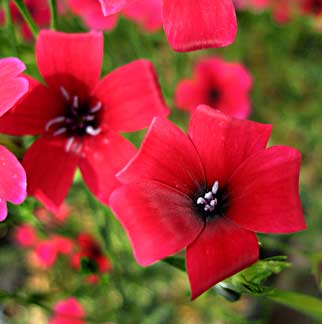
Viscaria oculata 'Tall Red', German Catchfly, 捕虫草, 石竹科
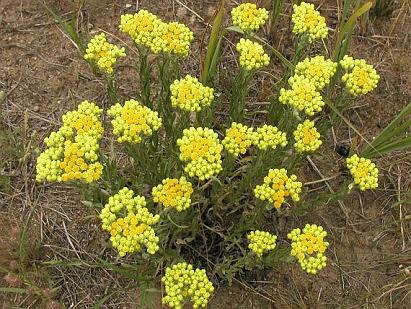
Helichrysum arenarium (L.) Moench. – Syn.: Gnaphalium arenarium L., Gnaphalium
aureum Gilib., Stoechas citrina Gueldenst., 蜡菊
Fields of Viper's-bugloss - Echium vulgare, BLUE, 蓝蓟, 紫草科
5月31日到达Andrum,林奈对一种Corn-frogs的发声产生兴趣。虽然蛙就在水中,但
蛙鸣声好象几里地远传来,这样不至于被发现。他想到把人盖在木桶沉于水中发的声音
机制与此很相似,都能迷惑人。在Tunbyholm,他记载了一只Devine rod(发现失物的)
,欧洲中古一直有这个传说。他把钱包埋起来让人测定,终于证明“神杆”也不能。险
乎丢了他的钱包,包中还有100 ducats呢。6月10日他回到母校Lund大学,发现一切
都变了,变得认不得了,以前熟悉的植被都变得陌生,时间啊:
Pulicaria [P.vulgaris, marsh fleabane] in my day grew in one or two places
only; now it is to be found on every wall. Carduus nutans [musk thistle],
which I had not seen outside Gotland, was also as common on the walls
as the former. Anagallis [pimpernel], which is never to be found further
north, grew there too and in the fallow fields; it opens all its flower at 8
a.m. and closes them at midday...
他对植物开花的时间的准确性开始留意,Crepis(hawksbeard,还羊参,一种菊类)准
六点开,六点半开全,Leontodon(hawkbit,狮齿菊)早晨六七点之间开放,晚上,六
点半还羊参合,七点全合闭。狮齿菊要早一些,五点到六点间。他把花放到室内,还羊
参还是很精确地开合,狮齿菊开花不早于六点,晚六点合闭。林奈由此想到植物钟,此
仍在Uppsala他的植物园中,可惜我去的时候早已不是花的季节。

Hortus Botanicus, PARADISUS dictus, alat plantas numerosissimas.
-- Philosophia Botanica: Carl Linnaeus, 1751
6 AM Spotted Cat’s-ear opens
7 AM African Marigold opens
8 AM Mouse-ear Hawkweed opens
9 AM Prickly Sow-thistle closes
10 AM Nippleworth closes
11 AM Star of Bethlehem opens
Noon Passion-flower opens
1 PM Childing Pink closes
2 PM Scarlet Pimpernell closes
3 PM Hawkbit closes
4 PM Small Bindweed closes
5 PM Water-lily closes
6 PM Evening Primrose opens
《植物哲学》一书中,他阐述了植物物候观测的目的和方法,制订了植物物候观测的
标准。他的植物日历记载有各地植物展叶、开花、果实成熟和落叶的日期,并附有气
候观测记录。1756年经过几年不间断的物候观察,林奈和他的学生Alexander Berger
完成和发表了广受关注的论文《花历》Calendarium florae. Defended 31 March
1756 by Alexander Malachias Berger (1737-1804).
还在是隆德田野,除了一派田园诗意味Every morning early, in everyvillage and
town on the plain, the shepherds blew their horns and shook their rattles.
Then the girls let out the cows, which were collected from all the houses
at the same time...林奈留意到瑞典农作方式的落后,并急急提议要改进:A serious
illness is never cured, except by sheer good luck, unless the doctor is properly
trained in medicine. I have taken on myself to diagnose the illness; I must
now see if I can suggest the cure.
&
前一贴提到宗教情怀,我想在这一贴里花一些篇幅谈谈医。林奈是一个专业医生,现
在看来是蒙古医生也说不定,十八世纪,医生很了不起,能当首相。林奈的许多弟子
也以行医的名义出行,确实他们能医治诸病,草药强,外科更拿得出手。这给他们的
自然行旅也很有益,比如路上生了病,都能自疗自慰。我想到李时珍,他的探行也是
因为自身草药在行,相比之下徐霞客就差一些。拿李时珍与林奈作比,会是一个很大
的课题,我哪里说得动呢?还是专心谈林奈医学成就,好在我一本德文传记是医学专
家写的。我一边宣科,一边学习。
林奈一生的医学专著不少,当然,都是启蒙时代的标准。此外他在乌普萨拉提出187
个议题中,有85个是有关医学的课题:
He [Linnaeus] dictated the sissertations both in Swedish and in Latin, the
correction and polishing of the text being left to the candidates; and although
he did not concern himself about the Latin, he nevertheless showed his
approval when they were well written, and vice versa. To write a disputation,
therefore, took barely three hours, for essentially it was simply a lecture
on the subject, copied down by the candidate.
林奈的博士论文是研究疟疾的,他认为是泥土影起,还有不卫生的饮水,里头恐怕有
许多小虫子。林奈手头有一个显微镜,上面说过虎克发明被列文虎应用研究微生物的,
可惜林奈在微病菌研究上没有上进。林奈思想还是偏综合,仰赖于自己的体系。1757
年他写过一篇Febris Upsaliensis [Uppsala Fever],强调城市卫生的改进,尤其是
饮用水。
...the majority of cases this was a tertian malaria, which in the 18 century
ws endemic in the whole Baltic region. In a letter to Sauvages, Linnaeus
reports a flare-up of the disease in Uppsala, where, in the last three months
of 1754, 300 persons fell ill, among them his own wife. Her symptoms are
so clearly described that the disease can be diagnosed today as a malarial
infection of the tertiary type. As a proven remedy Linnaeus made use of
cinchona bark, though he also recommended other ways and medicals.
林奈热爱大自然,尤其是拉普兰一行对原住民身体健实的观察记忆,使得他一生畅导
饮食学(dietetics,营养学?)。When I saw the healthy Lapps I hit upon certain
principles through which men could double the length of their lives, whthout
sick sickness and on natural principles.从古往希腊以来的作者他都做了通盘研究
,并写了Lachesis naturalis,作了不少公开演讲,Diaeta naturalis;公开演讲系列
的题目Diaeta experimentalis,他列述了不少格言:
Habit is, so to speak, our second nature.
All excess is harmful.
All boiled drinks, including water, are worse than unboiled ones.
Medical science without diet is of little use. He is a fool who trusts medicine when diet can help.
The face is the mirror of body and soul. etc. etc.
饮食或营养学就不多述了,此古印度也一样讲究,究竟非林奈独有。但人是自己最重要
的医生,吃什么,你就长什么,还是自然的。林奈除了疟疾,还对当时的常见病做过广
泛研究,麻疯leprosy(1765), 坏血病scurvy(1775), 麦角中毒ergotism(1763)以及
各种职业病occupational ailments(1765)。他用北欧一种芥辣菜Sauerkeraut治坏
血病。麦角毒前面弟子篇是因过,林奈取名Raphania,以为野芥菜因: St. Anthony's
fire, caused by contamination of grain through Raphanus raphanistrum.
他的论文Morbi artificum[工作病]他的论文工作病,林奈总结了意大利职业病发现者
Ramazzini的分析。此外透过他在瑞典各行业的观察分析,提供一些职业的具体病例,
比如行医行业的: During their visits with patients, Doctors are often infected
by epidemic illnesses such as the plague, typhus, dysentery, intermittent
fever, and coughs; by bad air when they sit at sickbeds; and also by
brooding (ruminating) they become melancholy.
有些病从一个人传到另一个人,传染病古已知之。17世纪已有细菌理论,虽有点道尔
顿的原子论,以对应物理医学与化学医学派。发展的过程总是缓慢,pathologia nimata
held microorganisms responsible for the obvious contagiousness of conspicuous
diseases, the extremists among them saw in microorganism the only cause
of all health disturbances.林奈虽不极端,也认为微生物引起诸种病,在1750年
科学会发表的Transactions他写道:It can very possibly be that smallpox, measles,
dysentery, syphilis - yes, the plague itself - are caused by the smallest
worms.以后他还有两篇论文(1757,1767)谈到animalcula viva在whooping cough,
smallpox, intermittent fever, tuberculosis, leprosy病中的要害角色。他以螨
(acarus)虫mites引起疥疮(scabies)作为凭据。虽然他手头有一部显微镜(loup microscope)
,但也没有做更深入的研究。启蒙时代的人都有点大大趔趔,具体的投入也许条件
不成熟,也许性格使然,让后人去做。毕竟,他的心思已放在植物分类上。虽然,
他的论文Mundus invisibilis[看不见的世界]中他说:
Its is no wonder that these microorganisms which, in respect to smallness,
exceed a hundredfold the dust particles dancing in a sunbeam, can drift
about in the air and be broadcast everywhee. They very smallest animals
quite possibly cause greater devastations than the largest; yes, they perhaps
kill more men than all the wars.
当然,林奈最强的肯定是草药学materia medica领域,届于他的植物学背景。在斯德
哥尔摩行医期间他一直专注于1686的药物宝典Stockholm Pharmacopeia的药方medi
-caments,这官方钦定的药物说明dispensatory,还有1699年的medical list。他
把钦定药物按他的系统重新分类,添加药物处理与用取说明。这里的工作不亚于李时珍
了。通过他医学院长的朋友Abraham Bäck,并由皇家资助,1774年第一本瑞典药方
书得以发行。这是公益事业,不讲私名,虽然他具体的著作还有一些:in 1749 Materia
medica in which medicines from vegetable sources are treated; a year later
a dissertation describing medicines from the animal kingdom; and in 1752, in
another dissertation, an inventory of the remedies from the mineral kingdom.
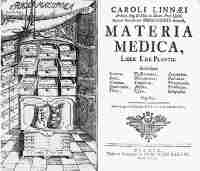
In 1749 he published Materia medica. That’s a Latin term for medicine and
the book is a list of plants, minerals and animals that Linnaeus considered
could be used in medicine.
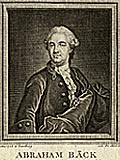
在药物学具体领域中他展开许多讨论,写了大量文章,一直倡导药典更新。独衷简单
的药方,他曾在Materia media中说:Whoever prescribes medicines with long
formulas sins, either out of deceitfulness or out of ignorance. 其后弟子J. C.
D. Schreber修订的莱比锡版本(1772)中他的药物学思想得到全面的贯彻。虽然第一
版只是一些参考医生、药剂师。In tabular form and with epigrammatic brevity,
the medical plants, for the most part tested by Linnaeus himself, were
listed, along with their alternative names, their place of origin, their pharma
-cological effect, the usual recommended form of application, and the
preparations in which they were contained.
林奈强调本土药物,不仅是国民经济,另外也新鲜,研究得彻底,合人心胃。在瑞典
南方广泛种植药物,1753年他给出一个名列。另外,他指导采药,保存,制药的具
体细节,着重提示药剂师要注意药物的纯净与药性。人类自右就尝试把药物分排别类。
林奈新的排列方式跟疗效挂勾,他以为相似类的植物有相类的疗效,这种思想至今还
是合理。另外,他把药物的气味与味道当作它们药效指标。这不自觉已涉及化学成份
。味重的药物,最影响神经系统。总之,他分排药植用的是十种气味,十种口味,药
物针对特别的病类。此思想至今未被科学证实。只是他这一方面的著述远不象他的植
物学那么广为人知,许多作品还是1954年瑞典林奈会(成立于1917年)编辑出版的。
他超强的观察与总结能力,使得他对每个问题都能作出一番结论,他反对医生开过重
的药物,说:whether a substance was to be regarded as a "poison" or a
"medicine" depended upon dosage, and that the exclusion of so-called
poisons from the medical armamentarium was simply a sign of ignorance
of the operation of medicine in general.
林奈编排病类系统,目的想从病征就轻易判断出病。他同样关注不同病群间的关系,
与不同药物类的关系。但那个时代病理学pathology几乎只注重病征,不太关于原因。
因此他的想法不能产生立即的效应,但对后世有启发,理性推断疾病一直是瑞典医
学的重要特点。
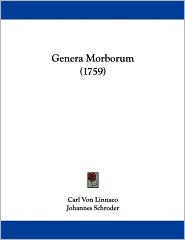
Genera Morborum (1759) by Carl Von Linnaeo
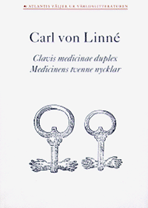
Clavis medicinae duplex [double key to medicine], a work of thirty-one
pages in which he sought to define the inner relationships between diagnosis
and therapy, between symptoms and the effect of medicine. This book is
also of tables, and its content can be interpreted oly with difficulty.
林奈说,即使最有学问的人也需要一生学习。人身体被比作植物结构,有皮(Corticale
vitale)有核(Medullare animale)。皮源于父,由骨、肌、血、肠。核源于母亲,
有脑与神经系统。皮属于外在Key,核Inner Key。Linnaeus's conception of the
effect of drugs is based on the notion that the bark is affected by medicines
characterized by taste and the core by those characterized by smell.
1732年秋天在Uppsala大学林奈首次接触外科手术,参加一个同学的私人讲座。林奈
的笔记一直保留下来。以后,他一直不相信外科手术界的专断与阶级分明which under
the leadership of able representatives educated abroad had emerged from
the condition of barber-sugeons.为保留他们的特权,竭力反对把手术置入大学课
程。1747年在De Chirugiae fundamento ex medicina [论手术的医学基础]他提出
A thorough knowledge of general medicine and above all of anatomy was
the indispensable prerequisite of any education in sugery and that could
only be offered at universities.
十年后,1758年,他强调一个结业的医学生必须亲眼目睹一次医院手术。让他高兴
的是,1775年他的弟子Adolf Murray被授以解剖与外手术主席,外科不久就在乌普
萨拉大学成立一系。
林奈重视公共卫生事业,他对Pomerania(1757-62)战争中军医不合格表愤怒。军
方政界当然对他不予理会,林奈一直把饮食学与公共卫合结合在一起,并由大学的医
生与牧师传布开去。他着文宣传公众健康,以接受自然饮食,并论述白兰地、巧克力、
茶对身体有益。他也给公众提出动物的疾病,兽医也应专门教育。在兽医领域他有弟
子Pehr Hernquist。林奈在大学执掌过一段时间教务,那期间,说学生都不给他惹麻
烦。他不只是对学界有此提仪,并且对政界,甚至对当朝国王Adolphus Frederick
也如是倡议一种科学精神--If the sciences are to be brought to fruition with
proper vigor it is necessary:
that the sciences should be allowed to enjoy ennobling freedom,
that professors should be adequately compensated so that they do not have to divide up their time to earn a living,
that they should work in competition with one another and not under compulsion; for an unwilling nurse raises stepshildren,
that the sciences should be as attractively presented as possible to the student, so that the latter may feel spontaneous love for them,
that the youth who have made respectable progress in sciences should received credit and not have worked in vain.
to be continued...
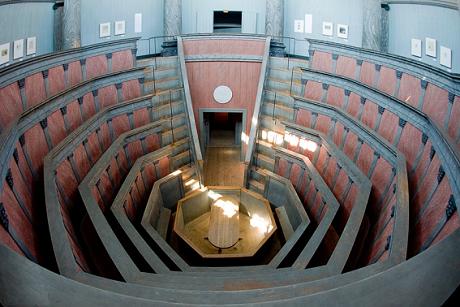
As King, Adolphus Frederick had even less influence in internal affairs than his predecessor, and his wife’s attempt to wield political power also failed. She was far more successful, however, in her efforts to advance the arts and sciences. The gifted son of Adophus Frederick and Louisa Ulrica came to the throne in 1771 as Gustavus III, and the following year he restored absolute power to the crown through a coup d’etat. The influence of the nobility and the estates was curtailed, the rights of the peasants were widened, and tortured was abolished, Gustavus III was assassinated by political opponents on March 16, 1792, at the opera ball in Stockholm.
A few European monarchs attempted to meet the challenge of the times by acting as representatives of enlightened absolutism. In Russia Peter the Great and Catherin II, born a princess of Anhalt-Zerbst and Czarina from 1762 to 1796, developed their country into a great European power. Frederick the Great who reigned from 1740 to 1786 and whose success at “inner colonization” was no less than his military accomplishments, established the power status of Prussia. The Holy Roman Emperor Joseph II, son of Frederick’s opponent the Archduchess Maria Theresa of Austria and coregent with her from 1765 until her death in 1780, acquired through a series of reform measures the reputation of being a humanitarian monarch, despite the fact that he brought upon his country several grave domestic and foreign crises. From 1715 to 1774 Louis XV was king of France; the powerful influence of his mistress Madame de Pompadour prevailed from 1743 to 1764. The first Hanoverian King of England, George I, ascended the throne in 1714; he was succeeded in 1727 by his son, George II. After the latter’s death in 1760, his grandson George Wilhelm Frederick, the first member of this dynasty to be born in England, took the throne as George III.
Nortern war (1700-21), the War of Spanish Succession(1701-14), the War of Austrian Succession (1740-48), the Seven Years’ War (1756-63), various Russo-Turkish wars, the American colonies’ War of Independence(1775-83).
Philosophy had such a powerful influence on the whole intellectual life of the eighteenth century that the names of at least the leading figures must be mentioned. Among the Germans, the activities of Gottfried Wilhelm von Leibniz(1646-1716) and of his follower Christian von Wolff fall at least partially within Linnaeus’s lifetime. The critic and dramatist Gotthold Ephraim Lessing (1729-81) was his contemporary; Lessing’s religious philosophy was deistic and critical of revelation. Another contemporary was Immanuel Kant(1714-1804) with whom the defeat of rationalism began. The French philosophical writers Voltaire and Jean-Jacques Rousseau both died in the same year as Linnaeus. Still another contemporary was Linnaeus’s fellow countryman Emanuel Swedenborg (1688-1772), versatile scholar, natural philosopher, and religious writer.
The Italian playwright Carlo Goldoni was born in the same year as Linnaeus. When Linnaeus died, Johann Wolfgang von Goethe was twenty-eight years old, and Friedrich Schiller, at eighteen, was studying to be an army doctor in the Karlsschule in Stuttgart. In the field of music, Johann Sebastian Bach died in 1750, Georg Friedrich Handel nine years later. Wolfgang Amadeus Mozart was born in 1756 and Ludwig van Beethoven in 1770.
Any orientation survey of the political, intellectual, and cultural background of Linnaeus’s life must mention mathematics, for this field was essential to the thinking of the period. Daniel Bernoulli(1700-83), a scion of the famous Basel family, physician and professor of anatomy and botany, later of physics, was co-founder of mathematical physics. The versatile and highly creative mathematician and physicist Leonhard Euler (1707-83) was born, like Bernoulli, in Basel. He went to St. Petersburg in 1730 and died there in 1783; from 1744-1776 he was active in the Berlin Academy of Sciences. For both these Basel scholars, mathematics, the epitome of sovereign reason for the men of the Enlightenment, was the favorite subject of study. But Linnaeus too was representative in his fashion of this tendency of the age. Through talent and insight, he became the systematizer of nature. The ground had been well prepared for his work.
林奈生平大事
1707年,出生于罗斯胡尔特,斯莫兰省
1727年,在隆德大学学习
1728年,乌普萨拉
1732年,拉普兰旅行
1734年,法轮与达拉那省旅行
1735-38年,游学丹麦、德、荷兰英法等国
1735年,获医学博士,Systema naturae(自然系统)第一版发行
1736年,出版Fundamenta botanica(植物学原理)
1737年,出版Flora Laponica(拉普兰植物志)
1739年,在斯德哥尔摩行医,创科学会,结婚
1741年,乌普萨拉医学教授,厄兰岛与高特兰岛旅行
1744年,担任乌普萨拉科学院秘书
1745年,出版Flora Suecica(瑞典植物志)
1746年,完成西约特省旅行,Fauna Suecica(瑞典动物志)
1749年,斯科纳省旅行
1751年,出版Philosophia botanica(植物哲学)
1753年,出版Species plantarum(植物类)
1758年,购买哈马比农庄Hammarby,Systema naturae第十版发行
1761年,被皇室加封
1766-68年,自然系统最后一版发行
1778年,林奈在乌普萨拉离世
1783年,林奈之子小卡尔去世
1784年,林奈收藏品出售给英国
